By Carlo Platella
Never change a winning team. A school of thought that is difficult to apply in Formula 1, where stopping development is a guarantee of defeat. However, Red Bull certainly does not give up its identity, evolving the same concept that has made it successful in recent years, together with an exceptional interpreter such as Max Verstappen. The setup of the RB20 is similar to that of the RB19, but aims to be a clear improvement, taking advantage of the abundant time available in 2023, when in Milton Keynes it was decided to interrupt the development of the previous car already in the summer.
The objectives of the project
The RB20 embodies the third stage of the concept on which Red Bull built its successes in the ground effect era. We started in 2022, when, rather than seeking maximum load, the choice was to build an aerodynamically robust platform, capable of generating constant and predictable grip in all conditions. Once the starting point was consolidated, aerodynamic efficiency was maximized with the 2023 car, also taking advantage of the regulatory changes that alleviated the gaps in the fastest corners.
With the third phase of the project, Red Bull has set itself specific objectives, well summarized by Ben Waterhouse, head of the performance engineering division, recently interviewed by Racecar Engineering: “There are areas we want to improve, be it performance at high or low speeds. At the same time, [la macchina] it had clear strong points, which we want to enhance while at the same time trying to address its critical issues”. The greatest advantage that the RB20 wants to preserve is aerodynamic efficiency, understood as the relationship between vertical thrust and resistance to advancement. It is no coincidence that Verstappen's clearest statements came in Barcelona, Spa and Suzuka, tracks that enhance efficiency.
In 2023 the RB19 won on 21 out of 22 tracks, denoting great versatility, however developed at the cost of less specificity. Verstappen has struggled to establish himself on circuits at the extremes of the calendar, both the low-load ones such as Las Vegas and Monza, and the more tortuous ones such as Singapore and Monaco. The RB20 aims precisely to cure these weak points, above all competitiveness in a maximum load configuration, digestion of bumps and curbs and agility in slower corners. For this reason, the 2024 Red Bull was created around a renewed chassis and suspension, a platform that will act as the basis for 2025, when investments will be aimed at the 2026 revolution.
Paradigm shift
Coming to the forms, rarely has a (non)presentation generated such dismay, triggering conjectures, bets and investigations on Milton Keynes' latest idea. Going in order, the RB20 maintains the same bodywork layout as the last two years, with the classic flat-panel layout to channel air into the lower part of the rear axle. What changes, however, is the strategy with which we want to enhance the underlying principle.
A central aspect of slide bellies is the channeling of flows along the lower contour of the side, transporting energy towards the diffuser environment and encouraging its work of extracting air from the bottom. In recent years teams have found it advantageous to widen and flatten the side vents, raising the leading edge of the bodywork to improve this channeling process. Red Bull development in 2023 focused precisely on this area, progressively thinning the radiator openings (1).
The crushing of the side intakes also has the purpose of pressurizing the environment at the sides of the passenger compartment. The objective is to increase local pressure, which can be used as a shield against external turbulence, preventing these from being sucked into the bottom. Thinning the radiator outlets helps to increase pressurization, a process which, however, has a limit. In fact, the contribution made by the air entering the bodywork is slowly reduced, as it travels more slowly and is at a higher pressure. Also for this reason, Red Bull has thought of a new approach, with the intention of going even further.
The mystery of the holds
Unfortunately, the images offered by the presentation of the RB20 do not allow us to fully understand the work of the Milton Keynes aerodynamicists. The impression is that Red Bull has dusted off the solution of the Mercedes with narrow bellies, with the vertical intakes that draw the air close to the chassis (2). Over time, Brackley's team abandoned this solution, also with the intention of removing a variable to understand the nature of the problems that gripped the black arrows.
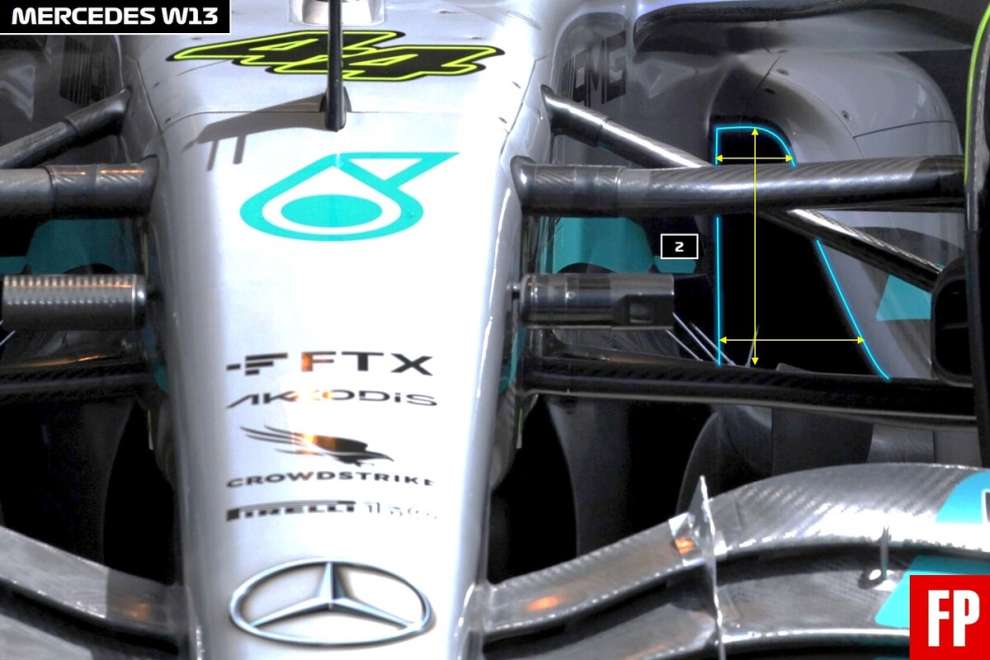
Some grainy shots of the RB20 suggest the presence of a thin vertical opening on the sides of the cockpit (3), which however does not exclude the presence of a second horizontal opening higher up. Furthermore, the hypothesis that the vertical slit is nothing other than the entrance to an internal Ferrari-inspired s-duct cannot be ruled out. What is certain is that the horizontal mouth with the lower lip stretched forward (4), an extension that now affects the upper edge, disappears.
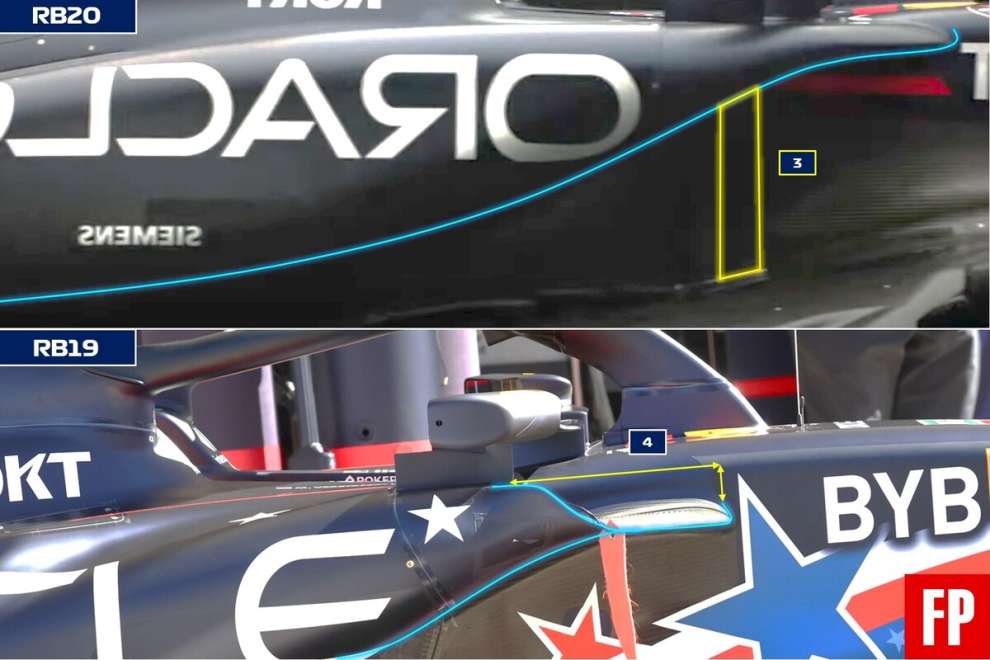
The new configuration of the air intakes presupposes a rethinking of the arrangement of both the upper impact cone and the internal components, cooling and electronics above all. It is further confirmation of a dynamic recently commented on these pages, namely that in an aerodynamic regulation where the floor interacts with the bodywork and encourages the search for complex geometries, the mechanical development under the skin is of absolute importance.
Car body
The continuity with the previous projects is perfectly recognizable in the sides, which maintain the flat-bellied layout. It is the emblem of how the solutions just commented on, however innovative, are not the symptom of a revolution, but rather accessories to enhance the same basic concept. Thanks to the raising of the leading edge of the air intakes, for example, the channeling of flows under the bodywork now begins in a raised position, resulting more progressive (5).
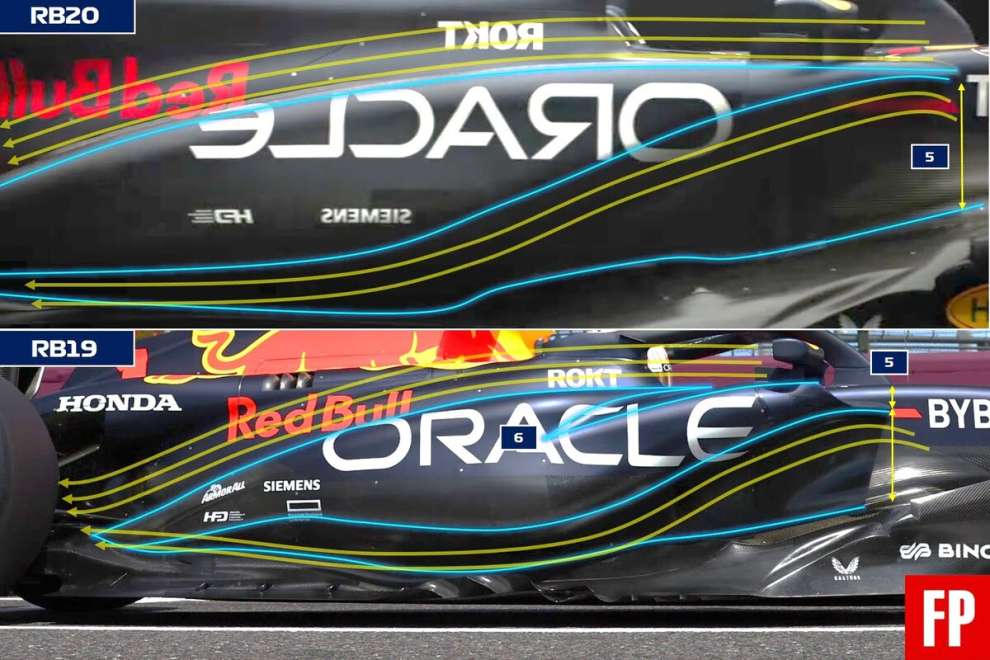
In the center of the belly, however, the triangular invitation that characterized the RB18 and RB19 (6) disappears. Finally, along the upper part, Red Bull continues on its path, without being tempted by the solutions of the competition. The slide ramps, in fact, are not dug and recessed into the bodywork (7), as is the case for example on Alpine, McLaren and Aston Martin.
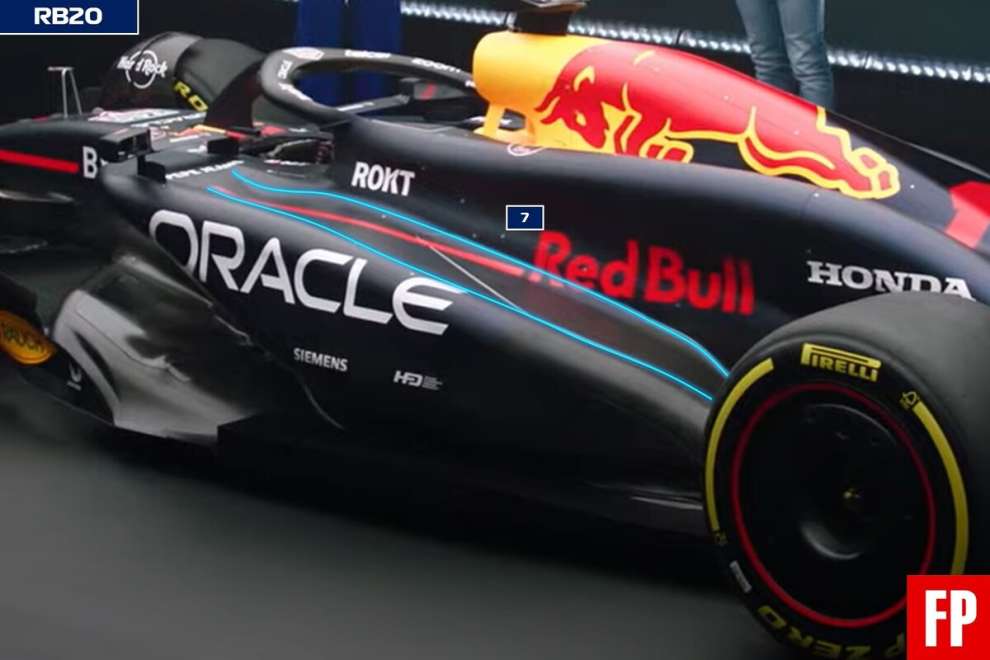
From halo to hood
In the upper part of the car, the dynamic air intake is larger than in 2023 (8), an area where at the time the team had instead saved weight, as it is the highest point of the car. This is an indication of how Red Bull now uses the central intake more to draw in the cooling air, which is necessary to compensate for the extreme narrowing of the side intakes.
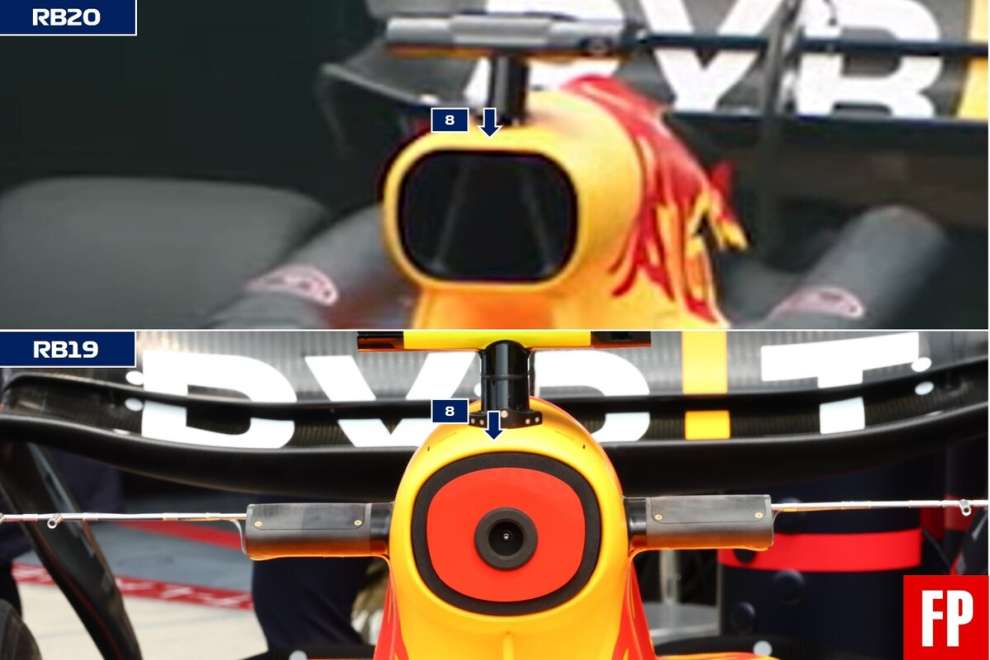
Immediately under the air-scope, the two supports of the anti-tipping structure (9) are now exposed, also used as flow diverters, against the “wire” visible on the RB19. Also appreciable is the perfect continuity in the surfaces between the halo and the bonnet (10).
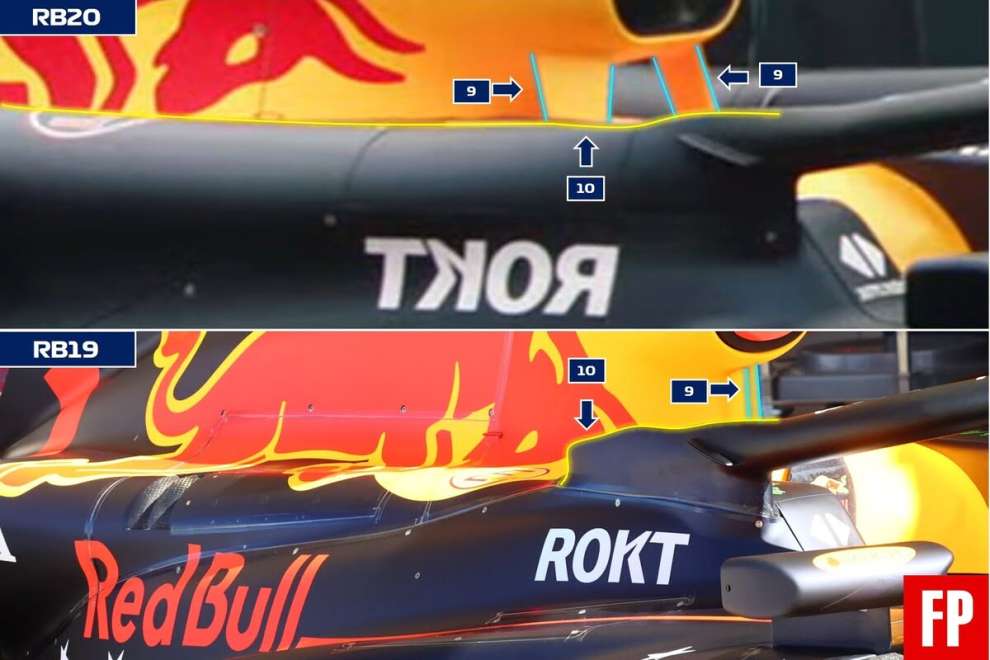
The bonnet itself draws inspiration from the 2023 Mercedes “tray”, a solution abandoned this year by the Brackley team. The bodywork is shaped in such a way as to outline two channels that isolate the hot air evacuated from the grills, preventing it from the flows that slide along the beaten bellies. The bonnet ends with a marked downward curve (11), which attracts and accelerates the flows near the rear wing, improving its performance.
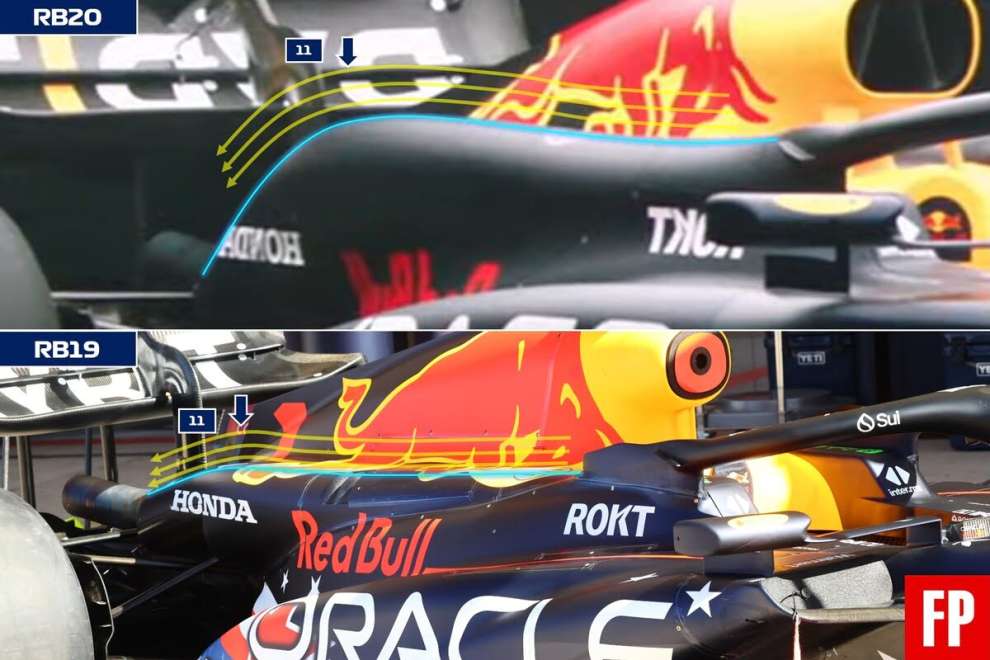
Suspensions
Red Bull continues with the proven mechanical platform of the last two seasons, terribly effective in stabilizing the surface while driving. The front suspension retains the pull-rod layout, with a strong anti-pitch kinematics (11) to stabilize forward rotations during braking. At the rear, the RB20 once again relies on the push-rod scheme, with the rod placed in front of the upper triangle. Any more accurate consideration on possible movements of the arms, both for the front and rear suspension, is postponed to the tests in Bahrain.
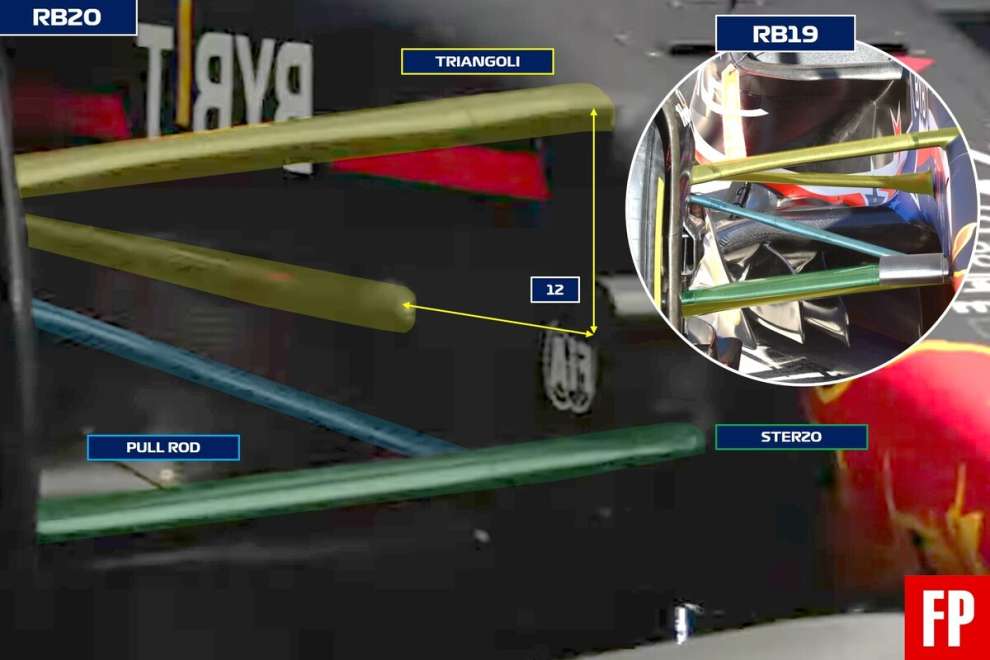
As per tradition, the team will not show the aerodynamic appendages before taking to the track. So far only the front wing stands out, with the nose extending up to the main profile, while in 2023 it stopped on the penultimate element (12).
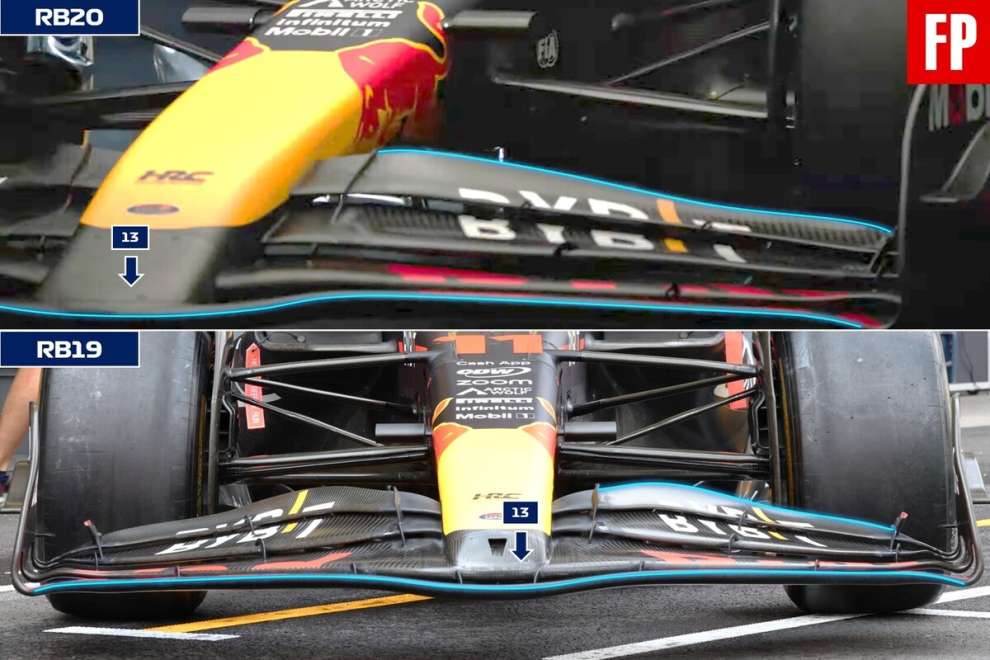
Aggressive evolution
Overall, the RB20 features many aggressive solutions, reversing in some areas the direction taken in 2023, in particular with regards to the air intakes. However, despite the dramatic shots, Red Bull chooses the path of continuity for 2024, evolving the same basic concept of the last two seasons. “Resources are limited, not everything can be done. We have chosen to develop what we have,” Adrian Newey's recent comment. “We don't know if it's the right choice or not if it turns out to be too conservative compared to what others have done”. Appointment in Bahrain to find out the answer.
#Red #Bull #technical #analysis #RB20 #rules #game
